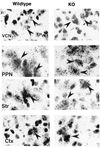Neuronal nitric oxide synthase alternatively spliced forms: prominent functional localizations in the brain
- PMID: 9096405
- PMCID: PMC20381
- DOI: 10.1073/pnas.94.7.3396
Neuronal nitric oxide synthase alternatively spliced forms: prominent functional localizations in the brain
Abstract
Neuronal nitric-oxide synthase (nNOS) is subject to alternative splicing. In mice with targeted deletions of exon 2 (nNOS(delta/delta)), two alternatively spliced forms, nNOS beta and gamma, which lack exon 2, have been described. We have compared localizations of native nNOS alpha and nNOS beta and gamma by in situ hybridization and immunohistochemistry in wild-type and nNOS(delta/delta) mice. To assess nNOS catalytic activity in intact animals we localized citrulline, which is formed stoichiometrically with NO, by immunohistochemistry. nNOS beta is prominent in several brain regions of wild-type animals and shows 2-to 3-fold up-regulation in the cortex and striatum of nNOS(delta/delta) animals. The persistence of much nNOS mRNA and protein, and distinct citrulline immunoreactivity (cit-IR) in the ventral cochlear nuclei and some cit-IR in the striatum and lateral tegmental nuclei, indicate that nNOS beta is a major functional form of the enzyme in these regions. Thus, nNOS beta, and possibly other uncharacterized splice forms, appear to be important physiological sources of NO in discrete brain regions and may account for the relatively modest level of impairment in nNOS(delta/delta) animals.
Figures






References
-
- Schmidt H H H W, Walter U. Cell. 1994;78:919–925. - PubMed
-
- Garthwaite J, Boulton C L. Annu Rev Physiol. 1995;57:683–706. - PubMed
-
- Brenman J E, Chao D S, Gee S H, McGee A W, Craven S E, Santillano D R, Wu Z, Huang F, Xia H, Peters M F, Froehner S C, Bredt D S. Cell. 1996;84:757–767. - PubMed
-
- Silvagno F, Xia H, Bredt D S. J Biol Chem. 1996;271:11204–11208. - PubMed
Publication types
MeSH terms
Substances
Grants and funding
LinkOut - more resources
Full Text Sources

